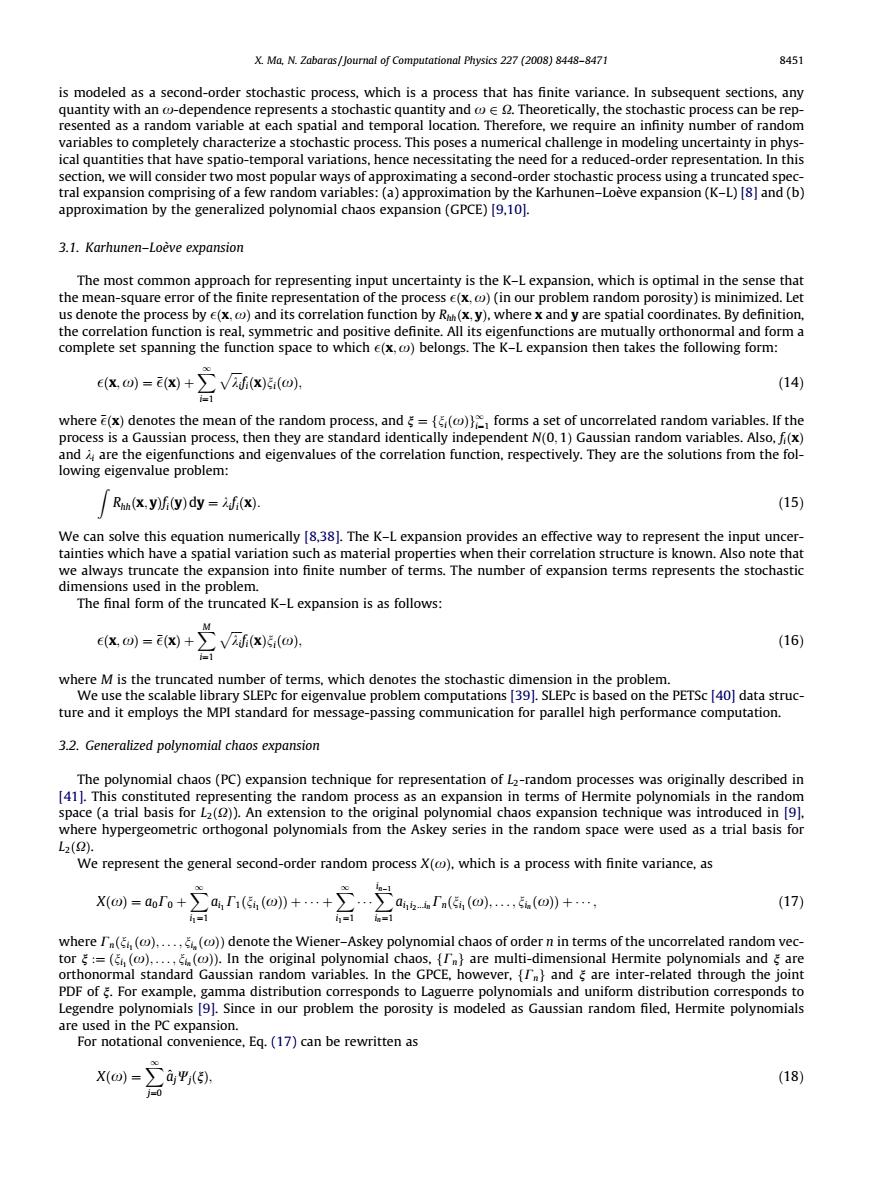正在加载图片...

X Ma N.Zabares/Joumal of Computational Physics 27(0)844-471 is modeled as a second-order stochastic process,which is a process that has finite variance.In subsequent sections,any e rep ()the Karhunen-Loevep(K)ad( approximation by the generalized polynomial chaos expansion(GPCE)9.10 3.1.Karhunen-Loeve expansion us denote the process by()byR).whereandyare spatia coordinates By x.)+)(). (14 a set of of the rv They are therom the Ra.(x.y)fi(y)dy if(x) (15 We can solve this equation numerically (838)The K-L expansion provides an effective way to represent the input uncer tainties which have a spatial variatic The final form of the truncated K-Lexpansion is as follows x-W+之Vx@ (16) where M is the truncated number of terms,which denotes the stochastic dimension in the problem age-p 32.Generalized polynomial chaos expansion 黑o四nd where hypergeometric orthogonal polynomials from the Askey series in the random space were used as a trial basis fo ,e pe the era-orerdmpehicwth he a「(a(@a(oj+ (17) where I(().....()denote the Wiener-Askey polynomial chaos of order n in terms of the uncorrelated random vec me For notational convenience.Eq.(17)can be rewritten as (18) is modeled as a second-order stochastic process, which is a process that has finite variance. In subsequent sections, any quantity with an x-dependence represents a stochastic quantity and x 2 X. Theoretically, the stochastic process can be represented as a random variable at each spatial and temporal location. Therefore, we require an infinity number of random variables to completely characterize a stochastic process. This poses a numerical challenge in modeling uncertainty in physical quantities that have spatio-temporal variations, hence necessitating the need for a reduced-order representation. In this section, we will consider two most popular ways of approximating a second-order stochastic process using a truncated spectral expansion comprising of a few random variables: (a) approximation by the Karhunen–Loève expansion (K–L) [8] and (b) approximation by the generalized polynomial chaos expansion (GPCE) [9,10]. 3.1. Karhunen–Loève expansion The most common approach for representing input uncertainty is the K–L expansion, which is optimal in the sense that the mean-square error of the finite representation of the process ðx;xÞ (in our problem random porosity) is minimized. Let us denote the process by ðx;xÞ and its correlation function by Rhhðx; yÞ, where x and y are spatial coordinates. By definition, the correlation function is real, symmetric and positive definite. All its eigenfunctions are mutually orthonormal and form a complete set spanning the function space to which ðx;xÞ belongs. The K–L expansion then takes the following form: ðx;xÞ ¼ ðxÞ þX1 i¼1 ffiffiffiffi ki p fiðxÞniðxÞ; ð14Þ where ðxÞ denotes the mean of the random process, and n ¼ fniðxÞg1 i¼1 forms a set of uncorrelated random variables. If the process is a Gaussian process, then they are standard identically independent Nð0; 1Þ Gaussian random variables. Also, fiðxÞ and ki are the eigenfunctions and eigenvalues of the correlation function, respectively. They are the solutions from the following eigenvalue problem: Z Rhhðx; yÞfiðyÞdy ¼ kifiðxÞ: ð15Þ We can solve this equation numerically [8,38]. The K–L expansion provides an effective way to represent the input uncertainties which have a spatial variation such as material properties when their correlation structure is known. Also note that we always truncate the expansion into finite number of terms. The number of expansion terms represents the stochastic dimensions used in the problem. The final form of the truncated K–L expansion is as follows: ðx;xÞ ¼ ðxÞ þXM i¼1 ffiffiffiffi ki p fiðxÞniðxÞ; ð16Þ where M is the truncated number of terms, which denotes the stochastic dimension in the problem. We use the scalable library SLEPc for eigenvalue problem computations [39]. SLEPc is based on the PETSc [40] data structure and it employs the MPI standard for message-passing communication for parallel high performance computation. 3.2. Generalized polynomial chaos expansion The polynomial chaos (PC) expansion technique for representation of L2-random processes was originally described in [41]. This constituted representing the random process as an expansion in terms of Hermite polynomials in the random space (a trial basis for L2ðXÞ). An extension to the original polynomial chaos expansion technique was introduced in [9], where hypergeometric orthogonal polynomials from the Askey series in the random space were used as a trial basis for L2ðXÞ. We represent the general second-order random process XðxÞ, which is a process with finite variance, as XðxÞ ¼ a0C0 þX1 i1¼1 ai1C1ðni1 ðxÞÞ þ þX1 i1¼1 Xin1 in¼1 ai1i2...inCnðni1 ðxÞ; ... ; nin ðxÞÞ þ ; ð17Þ where Cnðni1 ðxÞ; ... ; nin ðxÞÞ denote the Wiener–Askey polynomial chaos of order n in terms of the uncorrelated random vector n :¼ ðni1 ðxÞ; ... ; nin ðxÞÞ. In the original polynomial chaos, fCng are multi-dimensional Hermite polynomials and n are orthonormal standard Gaussian random variables. In the GPCE, however, fCng and n are inter-related through the joint PDF of n. For example, gamma distribution corresponds to Laguerre polynomials and uniform distribution corresponds to Legendre polynomials [9]. Since in our problem the porosity is modeled as Gaussian random filed, Hermite polynomials are used in the PC expansion. For notational convenience, Eq. (17) can be rewritten as XðxÞ ¼ X1 j¼0 a^jWjðnÞ; ð18Þ X. Ma, N. Zabaras / Journal of Computational Physics 227 (2008) 8448–8471 8451��������������������